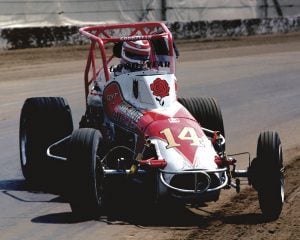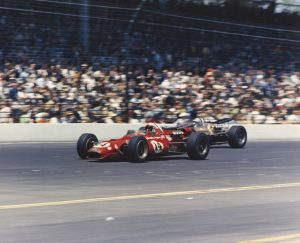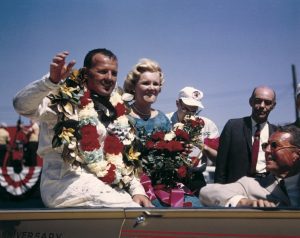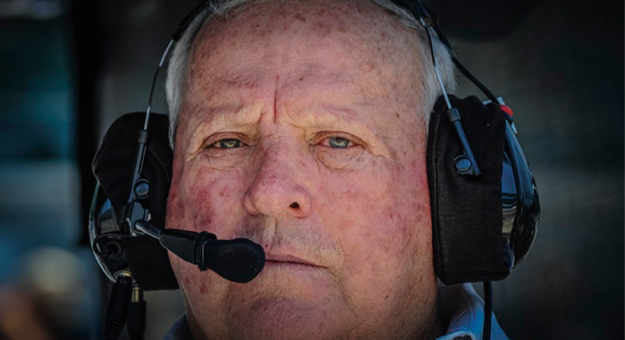Editor’s note: This story was originally published in the January 2015 edition of SPEED SPORT Magazine. We re-run it today in honor of Foyt’s 88th birthday.
When you hear the name A.J. Foyt, what’s the first thing that comes to mind?
For some, it’s the first four-time winner of the Indianapolis 500. For others, it’s 1972 Daytona 500 champion. For still others, it’s the 1967 winner of the 24 Hours of Le Mans, alongside Dan Gurney.
It could be something like “that crusty SOB from Texas who once threw Robin Miller in the trash can.”
Or how about the bigger-than-life hero of more than 100 dusty dirt tracks that grew into a legend very few men, if any, can compare to when it comes to driving a race car fast and beating whoever else was out there?
For anybody who knows enough about the history of motorsports in the period from 1958 to the present, the first thing anyone should think is “all-time great racing driver.”
“The thing about Foyt was, he never made a mistake,” was the way legendary reporter/broadcaster Chris Economaki, who was there when Foyt’s legendary career began and on the day his time behind the wheel came to an end, put it. “He was never the flashiest guy, or always the fastest, but he never beat himself. You could beat him, but he’d never beat himself.”
That’s a heck of a way to put it.
Titles, like greatest driver the world has ever known, for instance, are subjective things. Foyt won on the biggest stages in the world. Races such as the Indianapolis 500, Daytona 500 and 24 Hours of Le Mans — he’s the only driver to have won all three of those. His third Indy win came just two weeks before his Le Mans triumph. Foyt also twice won the Rolex 24 At Daytona and the 12 Hours of Sebring.

But others have accomplished similar feats. Mario Andretti, for instance, won the Daytona 500 in 1967 for Holman-Moody, took his only Indy crown in 1969 with Andy Granatelli and claimed the Formula One championship in 1978 for Colin Chapman and Lotus.
The superlatives, at least for American drivers, pretty much stop there. Dan Gurney was great at everything he did, but never won at Indy or Daytona. Dale Earnhardt never won the Indy 500, and neither did Richard Petty, though they both won at Daytona and scored 14 NASCAR Sprint Cup Series titles between them. One could throw Parnelli Jones in there, too, but he never won at Le Mans or Daytona.
Nothing against any of them because they are all great drivers and champions, but…they weren’t A.J. Foyt.
A driver with such a résumé would have to be larger than life, wouldn’t he?
“Foyt has always believed in God, America and himself — and not necessarily in that order,” wrote Larry Schwartz on ESPN.com. “A man of conviction, he is loyal to his friends and indifferent to his enemies. He is brash and blunt. He expected no quarter on the race track and gave none himself. He knew only one speed — pedal to the floor.”
That about sums him up, wouldn’t you say?
Foyt, who turns 88 years old on Jan. 16, came blowing out of Texas in the mid-1950s after driving open-wheel cars built by his father, Tony.
There’s the famous story of how he got started as a driver, too. His parents had left him at home one day, and as young boys will do, he wandered out to the garage and started tinkering with the mini midget his father had built for him to race around the backyard. Race is exactly what he did…until the engine caught fire. He was 3 years old.
Of course, imagine the surprise his parents had when they got home and found the yard all torn up, the car sitting out in the open, smoking still, and their young son fast asleep. Tony Foyt was anything but a “new age” parent, but somehow couldn’t bring himself to tan his young namesake’s backside for what could have been a tragic episode.
A couple of years later, in 1940, the younger Foyt drove in a match race against Doc Cossey, one of the Houston area’s top drivers. He beat him, too, in a car his father built just for him.
As he grew up, Foyt started to make a name for himself. Of course, it wasn’t always the name he wanted. His penchant for wearing brilliant white driving pants and colorful silk shirts saw him dubbed “fancy pants” by some of the more earthy drivers he competed against.
And he won races — lots of races. Starting in midgets and advancing to IMCA sprint cars, he rapidly progressed to USAC and the progress he made there caught the eye of Al Dean, who ran one of the big-time championship car teams.
That earned him a shot at the biggest prize of the era — Indianapolis.
His rookie year was 1958, and he qualified 10th for his first Indianapolis 500. That was a dark year at Indy with the death of the popular Pat O’Connor in a first-lap crash that involved 15 cars. Foyt missed that crash but eventually spun out after 148 laps and finished 16th.
Of the 33 drivers who started that race alongside Foyt, 15 later died behind the wheel of a race car. None of them got out of the sport without scars. That includes Foyt, who has more than his share of them.
One of the lasting legacies Foyt has left is, well, his longevity. He competed in every Indianapolis 500 from 1958 to ’92, a string of 35 straight Memorial Day classics. That is a record likely to never be broken.

Starting in that 1958 race, Foyt did not miss an Indy 500 until 1993. He didn’t miss it in 1966, not long after he fractured his back and broke a foot in a stock car race at California’s Riverside Int’l Raceway. In that crash, medics arrived on the scene and pronounced him dead because his skin was blue and he wasn’t breathing. One of the medics noticed he was still moving and, after scooping mud out of his mouth, rushed him to the hospital.
Ten weeks later, he won the pole for an Indy car race at Phoenix.
A year later, he was burned badly in a crash during practice. He raced.
In 1972, he broke his leg and was burned again while racing a championship car in DuQuoin, Ill. He raced.
In 1981, he qualified for the 500 and lost his mother to a heart attack later that night. He raced.
Two years later, he qualified on the first day at Indianapolis and found out that his father, his hero, his guiding force, had died of cancer. He raced. That, as well as his phenomenal success, was what marked A.J. Foyt as a hero.
If you look up famous quotes by A.J. Foyt, here’s one that comes up quite often: “Determination that just won’t quit — that’s what it takes.” Here’s another: “You get out front, you stay out front.”
Perhaps the victory that most people are familiar with is Foyt’s record fourth triumph in the Indianapolis 500.
Gordon Johncock had that race won. It would have been his second Indianapolis win and would have gone a long way toward erasing the bitter 1973 victory he had earned. That was the year Art Pollard died in practice, Swede Savage was fatally burned during the race and crewman Armando Tehran was killed on pit road, not to mention the botched start that saw Salt Walther tumble down the front straight and come to rest with his legs sticking out the shattered front of his McLaren.
Johncock, driving a bright red STP Wildcat for car owner Pat Patrick, had the lead late in the race, but it was very hot and humid for May in Indiana. On a pit stop at lap 159, the diminutive Michigan driver complained of heat exhaustion and dehydration, but still managed to exit the pits with a lead of more than 17 seconds.
Foyt had been tracking the leader all day and by the time the last stop of the day arrived, he had closed to within 10 seconds of Johncock. After pit stops by both drivers — Johncock at lap 181 and Foyt on lap 183 — the gap was seven seconds and closing.
As Johncock came off turn four to complete lap 184, his DGS-Offy coughed a plume of smoke as the crankshaft broke. Foyt sailed past and went on to win easily over Tom Sneva.

That was determination, and it was getting to the front and staying in front. It was also the last time Foyt would win a race at Indianapolis, but the record had been established — four Indy 500 victories. Al Unser and Rick Mears later tied his record in races in which Foyt competed, but no one has eclipsed it.
Part of Foyt’s legend — some say the major part — has to do with his fiery temper and his blunt way of speaking.
When he was angry, there were very few boundaries. His father, Tony, had a temper, too, and young A.J. was often the object of it. Perhaps the most vivid example of A.J.’s temper came at Indianapolis in 1982 when California rookie Kevin Cogan triggered a front-straight crash on the initial start that caught several other cars, including Foyt’s and those of Mario Andretti, Don Whittington and Spike Gelhausen.
Asked who caused the crash, an irate Foyt shouted, “That damn Coogan!” It was one of the more memorable images that year as was Foyt beating on his car with a hammer and chisel after mechanical problems cropped up 30 laps later. He could throw a Texas-sized fit when the situation called for it.
Just ask former Indianapolis Star writer Robin Miller. Once, when Miller had written something Foyt didn’t agree with (it was a note saying that the paddock was talking about how fast he was down the straightaways that pissed him off), Foyt took the direct route and roughed him up a bit.
In 1987, when his qualifying effort fell short of his expectation — he had asked March chassis designer Robin Herd for setup tips that didn’t pan out — he blurted out on the public-address system that the car “drove like a tub of shit.”
Foyt had heroes, too, but they were few and far between. His father, of course, was his first hero. The second? Who else but John Wayne? “I just respected the way that he acted,” Foyt said of “The Duke.”
If you need to have heroes — and everyone does — then your father and John Wayne are right up there in the pantheon.
To many, especially young men who grew up around the sport, Foyt was a hero as well. One such young man, Tony Stewart, has spoken often of his admiration for the legendary Texan. Stewart’s father, Nelson, shared it, naming his young son Anthony, and his NASCAR stock cars wear the No. 14 Foyt made famous.
There’s another similarity between Stewart and Foyt — and it’s not the sometimes mercurial nature they both share. They both set records while racing with the United States Auto Club.
Foyt earned a record 20-plus victories in USAC’s Indy car (67), stock car (41), sprint car (28) and midget (20) categories, and won both the Indy car and stock car titles in the same year — 1979. Stewart won the Triple Crown (Silver Crown, sprint car and midget) titles in 1995, becoming the first driver to deliver the hat trick of USAC titles in a single season.
They like and respect each other, too. Foyt says Stewart tells it like it is, even if it isn’t what everyone else wants to hear, and that’s how Foyt has always been.
Foyt, at Stewart’s debut race as a NASCAR team owner in 2009, said Stewart was just like him…in a distinctly Foyt-ish way.
“He calls a spade a spade,” Foyt said of Stewart. “Somewhere down the line, our genes must have crossed. That’s what made me what I am. I didn’t sugarcoat stuff. Tell fans the truth. That’s one thing I respect Tony for over some other drivers.”
So, how is Stewart like him, Foyt was asked.
“Well, excuse my French,” Foyt said, “but he’s known to be an asshole sometimes.”
“Don’t worry,” Stewart said. “That’s not the first time he’s told me that.”
Foyt underwent a triple bypass surgery in November that kept him in the hospital nearly three weeks.
Although surgery was successful, Foyt developed serious complications with his lungs, was on a ventilator for eight days and spent 10 days in intensive care.
“It’s been pretty rough but I guess I slept through the roughest part,” said Foyt after he was released from Baylor St. Luke’s Medical Center on Dec. 2. “I had some problems that most people don’t have after open heart surgery so I made my doctors work extra hard, but they saved my life. We’ve turned a corner so everything’s pretty good. I’ve got a long way to go but I’m feeling better every day.”
Happy birthday to American icon A.J. Foyt.
